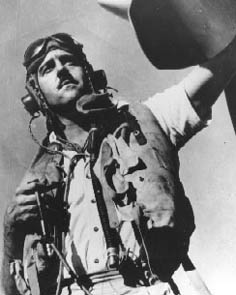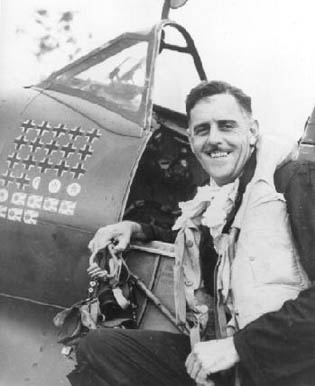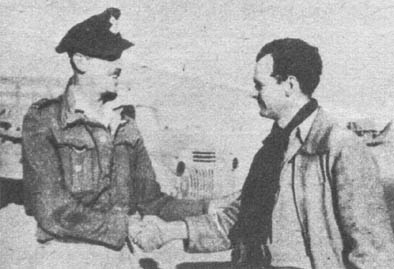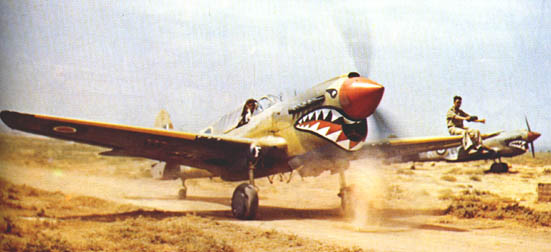
Photos: RAAF Museum (2) and Skrzydlata Polska (1).
Clive "Killer" Caldwell - Stuka Party
Written by George Dragicevic
Portrait of Group Captain Clive Caldwell, DSO, DFC & Bar,
Polish Cross of Valour.
Clive Robertson Caldwell was born in Lewisham, Sydney on the 28th of July,
1911. Pre war he trained for his civil pilot's licence whilst a member of the
Royal Aero Club. He joined the RAAF at the beginning of the war in 1939 and was
commissioned as a Pilot Officer in 1940. As he was destined to become an
instructor after completing his training, he resigned and re-applied as an
air-crew trainee. His commission was reinstated in January 1941, and he was sent
to the Middle East where he took up flying duties in Tomahawks with 250 Squadron
RAF. Following a short period of operations in Syria and Cyprus, Caldwell and
the squadron were relocated to the Western Desert. It was in this theatre that
he achieved great success during intensive operations.
 By mid-1941, Caldwell had flown about 40 operational sorties, but had only one
confirmed kill - a Bf 109. He was perplexed by the fact that he had trouble
scoring hits on enemy aircraft. Whilst returning to base one day, he noted his
squadron's aircraft casting shadows on the desert below. He fired a burst of his
guns and noted the fall of shot relative to his shadow. He realised this method
allowed for the assessment of required deflection to hit moving targets. Further
experimentation lead him to acquire the knowledge to assess deflection needed
for a range of speeds. Within a couple of weeks he had attained four further
kills and a half share. Caldwell's method of "shadow shooting" became a standard
method of gunnery practice in the Middle East.
By mid-1941, Caldwell had flown about 40 operational sorties, but had only one
confirmed kill - a Bf 109. He was perplexed by the fact that he had trouble
scoring hits on enemy aircraft. Whilst returning to base one day, he noted his
squadron's aircraft casting shadows on the desert below. He fired a burst of his
guns and noted the fall of shot relative to his shadow. He realised this method
allowed for the assessment of required deflection to hit moving targets. Further
experimentation lead him to acquire the knowledge to assess deflection needed
for a range of speeds. Within a couple of weeks he had attained four further
kills and a half share. Caldwell's method of "shadow shooting" became a standard
method of gunnery practice in the Middle East.
On 29 August 1941 Clive Caldwell was attacked by two Bf 109s North-West of
Sidi Barrani. One of his attackers was the Bf 109 E-7 "black 8" of 2./JG 27
piloted by one of Germany's top aces, Leutnant Werner Schroer who was credited
with 114 Allied planes in only 197 combat missions. Caldwell's P-40 "Tomahawk"
of 250 Squadron was riddled with more than 100 rounds of 7.9 mm slugs, plus five
20 mm cannon strikes which punctured a tyre and rendered the flaps inoperative.
In the first attack Caldwell suffered bullet wounds to the back, left shoulder,
and leg. In the next pass one shot slammed through the canopy, causing splinters
which wounded him with perspex in the face and shrapnel in the neck. Two cannon
shells also punched their way through the rear fuselage just behind him and the
starboard wing was badly damaged. Despite damage to both himself and the
aircraft, Caldwell, feeling, as he remembers, "quite hostile" turned on his
attackers and sent down one of the Bf 109s in flames. The pilot of the second
Messerschmitt, the renowned Leutnant Schroer, shocked by this turn of events,
evidently made off in some haste. Caldwell's engine had caught fire, however he
managed to extinguish the flames with a violent slip. He then nursed his flying
wreck back to base at Sidi Haneish.
Caldwell's most successful day was the 5th of December 1941 when he shot down
five Ju 87s in a single engagement during operation "Crusader". Here is the
combat report of that action:
"I received radio warning that a large enemy formation was approaching from
the North-West. No. 250 Squadron went into line astern behind me and as No. 112
Squadron engaged the escorting enemy fighters we attacked the JUs from the rear
quarter. At 300 yards I opened fire with all my guns at the leader of one of the
rear sections of three, allowing too little deflection, and hit No. 2 and No. 3,
one of which burst into flames immediately, the other going down smoking and
went into flames after losing about 1000 feet. I then attacked the leader of the
rear section...from below and behind, opening fire with all guns at very close
range. The enemy aircraft turned over and dived steeply...opened fire [at
another Ju 87] again at close range, the enemy caught fire...and crashed in
flames. I was able to pull up under the belly of one of the rear, holding the
burst until very close range. The enemy...caught fire and dived into the
ground."
Due to his aggressiveness, exceptional combat skills, and determination to
strafe ground targets, Caldwell soon acquired the nickname "Killer" which he
apparently was not particularly proud of. The name however stuck and was
commonly used in referring to Caldwell. In opinion of Wing Commander R.H.
"Bobby" Gibbes (he battled in 3 Sqdn RAAF in North Africa and in the SW Pacific
under Caldwell's command): "Clive Caldwell was given the name "Killer" (a name
which was not of his choosing or liking) due to his habit of shooting up any
enemy vehicle which he saw below when returning from a sortie. Invariably he
landed back at his base with almost no ammunition left."
Caldwell was promoted to flight commander in November 1941 and received the
DFC and Bar simultaneously on December 26 by which time he had 17 victories. He
was promoted to Squadron Leader in January 1942 and took command of 112 Squadron
RAF flying Kittyhawks. It was due to his leadership, confidence and daring, his
work with a contingent of Polish pilots attached to 112 Squadron, and continued
success with this squadron that he received the Polish Cross of Valour (Krzyz
Walecznych).
 In contrast with the great successes of
Skalski's Circus
, Polish pilots' endeavours with 112 Squadron weren't as fruitful. A group of 12
Polish ferry-transport pilots volunteered for RAF service on 29 August 1941 and
after training they joined "Shark" squadron in February 1942. On 14 February,
1942 the patrolling 112 Sqn RAF and 3 Sqn RAAF encountered a formation of 32
enemy aircraft and Sec.Ltn. Dula downed an MC 200. In combat with 6 Bf 109
fighters from I/JG 27 on 21 February 1942 three "Kittyhawks" of 112 Sqn were
downed, two of them piloted by Polish pilots: Sgt. Derma and Ltn. Jander. On 13
March 1942 pilots P/O Bartle (English) and Sgt. Rozanski (Polish) left a
formation of 12 "Sharks" in the Tobruk area and they were caught by surprise and
attacked by Oberfeldtwebel Otto Schulz (4./JG 27, MIA on 17 June 1942, 42
victories). Both were downed, but Rozanski luckily escaped his crashed, burning
aircraft. On the following day Sgt. Urbanczyk together with S/L Caldwell got one
Bf 109. On 15 March 1942 112 Squadron was moved from the front line to Sidi
Haneish for replacements. Polish pilots didn't return to duty in this unit from
16 April 1942.
In contrast with the great successes of
Skalski's Circus
, Polish pilots' endeavours with 112 Squadron weren't as fruitful. A group of 12
Polish ferry-transport pilots volunteered for RAF service on 29 August 1941 and
after training they joined "Shark" squadron in February 1942. On 14 February,
1942 the patrolling 112 Sqn RAF and 3 Sqn RAAF encountered a formation of 32
enemy aircraft and Sec.Ltn. Dula downed an MC 200. In combat with 6 Bf 109
fighters from I/JG 27 on 21 February 1942 three "Kittyhawks" of 112 Sqn were
downed, two of them piloted by Polish pilots: Sgt. Derma and Ltn. Jander. On 13
March 1942 pilots P/O Bartle (English) and Sgt. Rozanski (Polish) left a
formation of 12 "Sharks" in the Tobruk area and they were caught by surprise and
attacked by Oberfeldtwebel Otto Schulz (4./JG 27, MIA on 17 June 1942, 42
victories). Both were downed, but Rozanski luckily escaped his crashed, burning
aircraft. On the following day Sgt. Urbanczyk together with S/L Caldwell got one
Bf 109. On 15 March 1942 112 Squadron was moved from the front line to Sidi
Haneish for replacements. Polish pilots didn't return to duty in this unit from
16 April 1942.
Whilst with 112 Squadron, the Australian government asked that he be released
to return to Australia to command a Wing in the defence of Australia. This Wing
was to consist of 3 Squadrons of "Spitfires", and Caldwell spent some time with
the Kenley Wing before returning home to acquaint himself with the new aircraft.
The Japanese were threatening Northern Australia, and several Australian towns
were regularly being bombed. Caldwell left the Middle East with nineteen
individual and three shared confirmed enemy kills, six probables, and fifteen
damaged.
On his departure from the Middle East, the Marshall of the RAF Lord Tedder
wrote of Caldwell: 'An excellent leader - and a first class shot.'
On taking up his command of No. 1 Fighter Wing based in Darwin, Caldwell
again showed his outstanding fighting abilities and claimed a further eight
Japanese aircraft by August 1943. Caldwell's tally was twenty-eight and a half
by the time he left the Wing in August and for this feat he received a DSO to
add to his DFC and Bar and Polish Cross of Valour.
The following table details Caldwell's tally of kills:
| Kill |
Date |
Type |
Result |
Locality |
| 1 |
26/6/41 |
Bf 109 (a) |
Destroyed |
Capuzzo |
| 2 |
30/6/41 |
Bf 110 (b) |
Destroyed (shared) |
off Tobruk |
| 3 |
30/6/41 |
Ju 87 (c) |
Destroyed |
off Tobruk |
| 4 |
30/6/41 |
Ju 87 |
Destroyed |
off Tobruk |
| 5 |
7/7/41 |
G.50 |
Destroyed |
Gazala |
| 6 |
16/8/41 |
G.50 |
Destroyed (shared) |
Convoy patrol |
| 7 |
29/8/41 |
Bf 109F |
Destroyed |
Sidi Barrani |
| 8 |
27/9/41 |
Bf 109 |
Destroyed |
BuqBuq |
| 9 |
28/9/41 |
Bf 109 |
Destroyed |
Bardia |
| 10 |
23/11/41 |
Bf 109 |
Destroyed |
Tobruk |
| 11 |
23/11/41 |
Bf 109 (d) |
Destroyed |
Baheira |
| 12 |
5/12/41 |
Ju 87 |
Destroyed |
S El Adem |
| 13 |
5/12/41 |
Ju 87 |
Destroyed |
S El Adem |
| 14 |
5/12/41 |
Ju 87 |
Destroyed |
S El Adem |
| 15 |
5/12/41 |
Ju 87 |
Destroyed |
S El Adem |
| 16 |
5/12/41 |
Ju 87 |
Destroyed |
S El Adem |
| 17 |
12/12/41 |
Bf 109 |
Destroyed |
Derna-Tmimi |
| 18 |
20/12/41 |
Bf 109 |
Destroyed |
S Barce |
| |
24/12/41 |
Bf 109 (e) |
Damaged |
|
| 19 |
21/2/42 |
Bf 109 (f) |
Destroyed |
Derna-Gazala |
| 20 |
14/3/42 |
C.202 |
Destroyed |
NW Tobruk |
| 21 |
14/3/42 |
C.202 |
Destroyed (shared) |
NW Tobruk |
| 22 |
23/4/42 |
Bf 109 |
Destroyed |
Bir Hacheim |
| 23 |
2/3/43 |
Zeke (A6M) |
Destroyed |
50 km WNW Pt Charles
|
| 24 |
2/3/43 |
Kate (B5N) |
Destroyed |
50 km WNW Pt Charles
|
| 25 |
2/5/43 |
Zeke (A6M) |
Destroyed |
65 to 95 km NW Darwin
|
| 26 |
2/5/43 |
Zeke (A6M) |
Destroyed |
65 to 95 km NW Darwin
|
| 27 |
20/6/43 |
Zeke (A6M) |
Destroyed |
SW Darwin |
| 28 |
30/6/43 |
Zeke (A6M) |
Destroyed |
65 km W Batchelor |
| 29 |
30/6/43 |
Betty (G4M) |
Destroyed |
65 km W Batchelor |
| 30 |
20/8/43 |
Dinah (Ki-46) (g) |
Destroyed |
30 km W Cape Fourcroy
|
(a) Bf 109E of I/JG27, flown by Lt. Heinz Scmidt; (b) Aircraft
of III/ZG26; (c) Ju87s of II/StG2, flown by Lt. Wagner and Uffz Walz; (d)
Leading Bf 109F of four; Hpt Wolfgang Lippert, Kommandeur of II/JG27 and
Knight's Cross holder, bailed out; (e) Bf 109F of III/JG27 damaged. Bullet hit
Oblt Erbo Graf von Kageneck, 69 victory 'Experte' and Knight's Cross holder, who
died of wounds in hospital on 12 Jan, 1942; (f) Bf 109F of II/JG27; Lt
Hans-Arnold Stahlschmidt crash landed; (g) Aircraft of 202 Sentai.
Caldwell returned to operations in April 1944 (after a period commanding an
OTU) commanding 80 Wing out of Darwin and Morotai. By this time opposition in
the air from the Japanese had waned, and the role of the RAAF in the South-West
Pacific had been relegated to a supporting role. 80 Wing was confined to
strafing and bombing ground targets which Caldwell and his pilots found wasteful
and frustrating. These targets were isolated from the main Japanese forces and
the pilots resented being risked in tasks whose results were making no
contribution towards winning the war. In April 1945, Caldwell and seven other
officers tended their resignations in protest (the so-called Morotai mutiny)
against the RAAF's role in the latter stages of the war. This action lead to a
command crisis in the RAAF where three senior officers including Air Commodore
Cobby (WW1 ace) were relieved of their duties. Caldwell finished the war
attached to HQ, 1st TAF, RAAF, based in Melbourne. He resigned from the RAAF in
1946 and was a successful businessman until his death on 5th of August, 1994.
References:
Spitfire, Mustang and Kittyhawk in Australian Service, Stewart Wilson Aerospace
Publications
High Flyers - Leaders of the Royal Australian Air Force, Alan Stephens & Jeff
Isaacs, AGPS publications
Aces High, Christopher Shores & Clive Williams, Grub St publishers
Air Force Australia, George Odgers, National Book Distributors
Australian Air Aces, Dennis Newton, Aerospace Publications
Pictorial History of the Royal Australian Air Force, George Odgers, Paul Hamlyn
publishers
Nice colour photo of "Kittyhawks" from 112 Squadron RAF, commanded by
Caldwell.

Photo: B. Gunston, Combat Aircraft of WW II, Tiger Books
1990.
